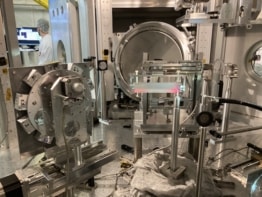
A thought experiment proposed more than 50 years ago by Richard Feynman has finally been realized in the lab by physicists in the US and China. “Feynman’s ratchet” is a microscopic heat engine that converts thermal fluctuations into work when connected to two heat sources at different temperatures. Although the device has a very low efficiency, its creators believe it could have a number of applications, such as providing a better understanding of molecular motors that drive living cells.
Feynman’s thought experiment is a way of showing how the second law of thermodynamics cannot be violated. He envisaged a tiny set of vanes attached to the end of a shaft that are bombarded by gas molecules in a box. The other end of the shaft is attached to a ratchet, so the wheel can only turn in one direction.
The idea is that the molecules in the gas strike the vanes from random directions due to their Brownian thermal motion. But because the shaft is also connected to the ratchet, only motion forcing the vanes to turn in one direction would result in the rotation of the shaft. The upshot would be directed motion – which could be harnessed to do work – generated from random thermal movements.
Jumping pawl
However, Feynman explained that the internal workings of the ratchet would prevent such directed motion from taking place. In a ratchet (see figure), a gear wheel with asymmetrical teeth can only turn in one direction because a spring-loaded “pawl” next to the wheel allows the more gently-sloping side of each tooth to run past the pawl – but blocks the steeper side when rotation is in the opposite direction. Feynman pointed out that if a ratchet could be made small enough to be turned by molecular collisions, the friction needed to prevent the pawl bouncing clear of the ratchet as it drops down from one tooth to the next would create enough heat to agitate molecules within the device and cause the pawl to jump up and allow the wheel to turn the wrong way. As with macroscopic heat engines, he concluded, there would have to be a temperature difference for the device to work – either the gas would have to be hotter than the pawl, or vice-versa.
Until now no-one has built such a tiny ratchet because of significant technical challenges that include how to prevent convection from washing out thermal fluctuations. But now Tongcang Li of Purdue University in the US and colleagues have succeeded using a 780 nm-diameter ball of silicon dioxide confined to a 1D optical trap set up inside a small tank of water.
The trap is created by combining 19 optical tweezers in one of two ways. Either the tweezers are overlapped to form a smooth, constant potential that leaves the ball free to move in either direction along the trap’s axis as it is knocked about by water molecules – in other words, the virtual ratchet and pawl are disengaged. Or the tweezers combine to create a saw-tooth potential, constraining the ball to move in one direction only – in which case ratchet and pawl are engaged.
Temperature difference
While the temperature of the gas is represented by the temperature of the water, the temperature of the pawl – the second heat reservoir – instead has a more abstract expression: the frequency with which the trap switches between saw-tooth and smooth potentials. The idea is that when the pawl is hotter it is more likely to jump up and allow the ratchet to turn the wrong way.
As Feynman predicted, when the two heat baths have the same temperature the ball is sometimes bounced slightly to the left and other times slightly to the right, but there is no net motion. But when they change the switching rate between the virtual ratchet’s two different states – so raising the temperature of one bath over the other – they find that the ball migrates along the trap. In other words, the ratchet undergoes a net rotation in one direction, which, they showed – by adding a slope to the flat potential – allows the system to perform work.
Feynman was wrong
The researchers also showed that Feynman got quite an important detail wrong. Feynman thought the ratchet could operate as efficiently as a Carnot engine, while other physicists have argued that is impossible because the device requires contact with two heat sources at the same time. In fact, Li and co-workers measured an efficiency of less than 1% – in contrast with the 90% theoretically possible for a Carnot engine operating between the temperatures in question.

No-way physics
Li says that the low efficiency is “a little bit disappointing” but insists that their device provides “an important platform to study microscopic heat engines”. He reckons it could shed light on the mechanisms underlying molecular motors, which, he says, involve Brownian motion and “are closer to Feynman’s ratchet than a Carnot engine”.
Ignacio Martínez of the Universidad Complutense de Madrid praises the team for its “beautiful study” in fundamental physics. He argues that the “kinetic” temperature and virtual pawl-ratchet system render the demonstration an “experimental simulation”, rather than a real engine. However, he believes the work could help develop technology that exploits fluctuations even on larger scales, such as charging small electronic devices using ambient electromagnetic waves. “These fundamental studies are a pivotal part of future applications,” he says.
The research is described in New Journal of Physics.



